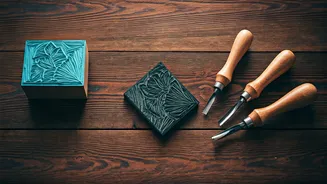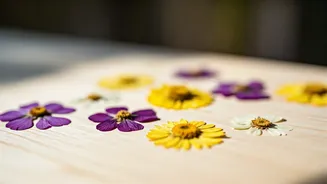Linocut Art Defined
Linocut is a printmaking technique that involves carving a design into a linoleum surface. This surface acts as a printing plate. The process starts with
transferring a design onto the linoleum. Using specialized tools, areas around the design are then carved away, leaving the desired image raised. Ink is then applied to the raised surface, and the inked linoleum is pressed onto paper, transferring the image. The results are unique prints that showcase the artist's style. This art form provides an accessible entry point into printmaking, suitable for beginners. Its simplicity, combined with its capacity for detailed imagery, makes it an attractive and rewarding pursuit. It allows for creative exploration and the production of multiple prints, each with their own unique character.
Essential Beginner Tools
To begin your linocut journey, a few essential tools are needed. First, you'll need linoleum blocks, the surface for carving. These blocks come in various sizes and thicknesses. Next, carving tools are crucial. These come with different shaped blades. These blades allow the artist to create lines, curves, and textures in the design. A bench hook or cutting mat will provide a stable surface for carving, ensuring safety and precision. The next required material is ink. Water-based inks are often preferable for beginners due to their ease of use and clean up. Finally, you will require a baren, or a printing press. The baren is used to apply even pressure to transfer the ink from the linoleum to the paper. All these tools are easily accessible online or in art supply stores. Investing in these essential tools will enable you to start on the path to making beautiful linocut prints.
Choosing the Right Materials
Selecting appropriate materials enhances the linocut experience and affects the quality of the prints. Start by selecting the right linoleum. Beginners can start with soft-cut linoleum blocks, which are easier to carve. Consider the paper for your prints. It's best to go for paper made for printmaking, which is absorbent and can handle the ink. Experiment with different weights and textures of paper to achieve varied effects. Choose high-quality ink that matches your creative vision. Water-based inks are often a good starting point for beginners because they are easy to work with. Always have access to a sturdy work surface and appropriate lighting. Protect your work surface with a cutting mat. The proper choice of materials gives beginners a good platform to experiment with and master the art form of linocut printmaking.
Mastering Carving Techniques
The art of carving is the heart of linocut printmaking. Begin by transferring your chosen design onto the linoleum block using tracing paper or by directly drawing on the surface. Start slowly. It's best to begin with simple designs to get a feel for the carving tools. Practice the techniques of holding the tools and directing them to make clean cuts. Using different blade shapes creates diverse lines and textures in your design. When carving, always cut away from yourself to avoid injuries. Remember to use the bench hook or cutting mat to prevent the block from slipping. Pay attention to the depth of your cuts; deeper cuts create wider lines. Regularly clean the linoleum surface during carving to remove any debris. By mastering these techniques, beginners can start to create detailed and striking linocut prints.
Printing Your First Design
Printing is the last, and often most rewarding, step of linocut printmaking. After carving the linoleum, it's time to ink the surface. Roll a thin, even layer of ink over the carved block. Be careful not to fill the carved-out areas with ink. Place your paper carefully onto the inked linoleum. To transfer the image, apply pressure either with a baren or using a printing press. Ensure even pressure over the entire surface of the linoleum. When printing with a baren, rub the baren firmly across the back of the paper. Gently lift a corner to check the print transfer. Once the image is transferred, carefully peel back the paper to reveal your print. Allow the print to dry completely before handling it. Beginners often find this stage exhilarating because it’s where their efforts in carving come to life, unveiling the final image. Each print showcases the artist’s unique style and vision.





